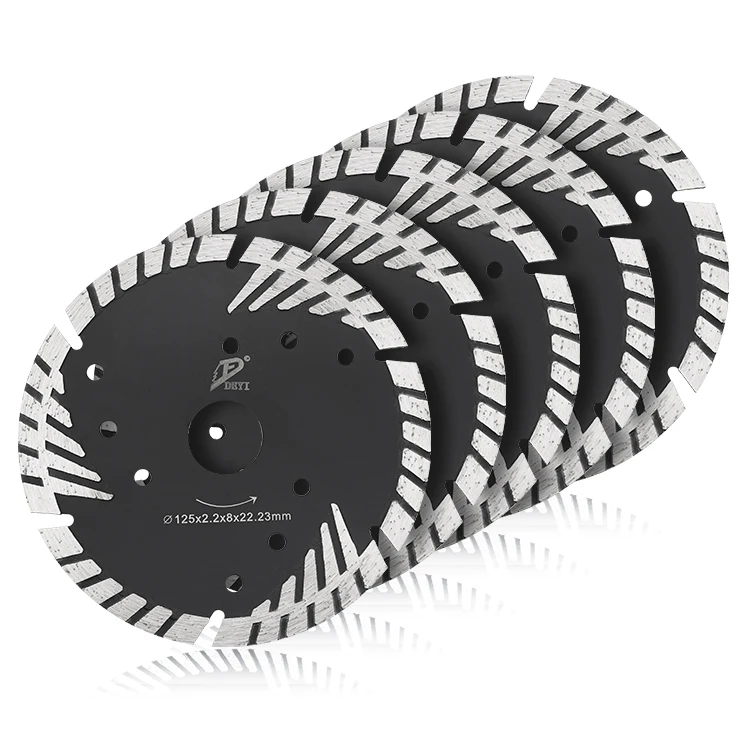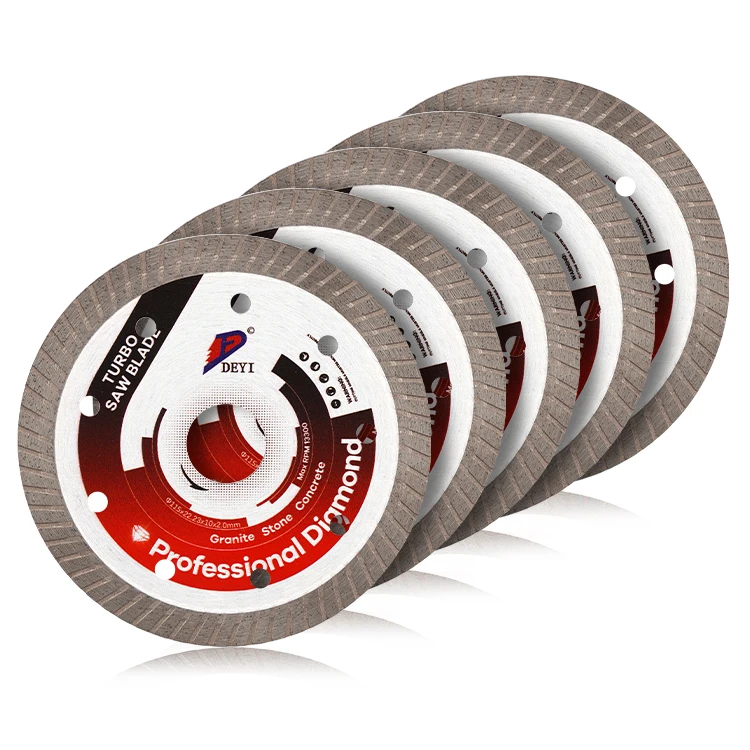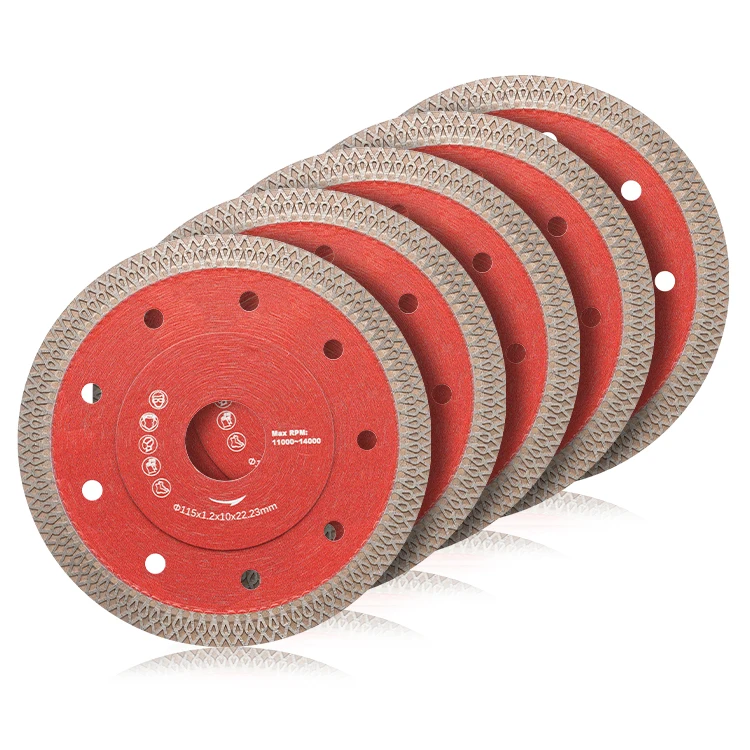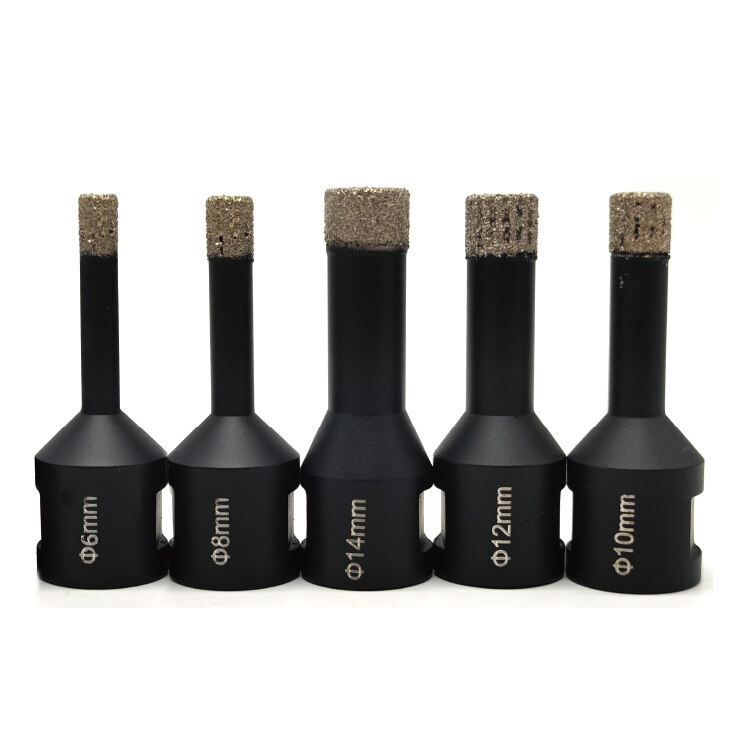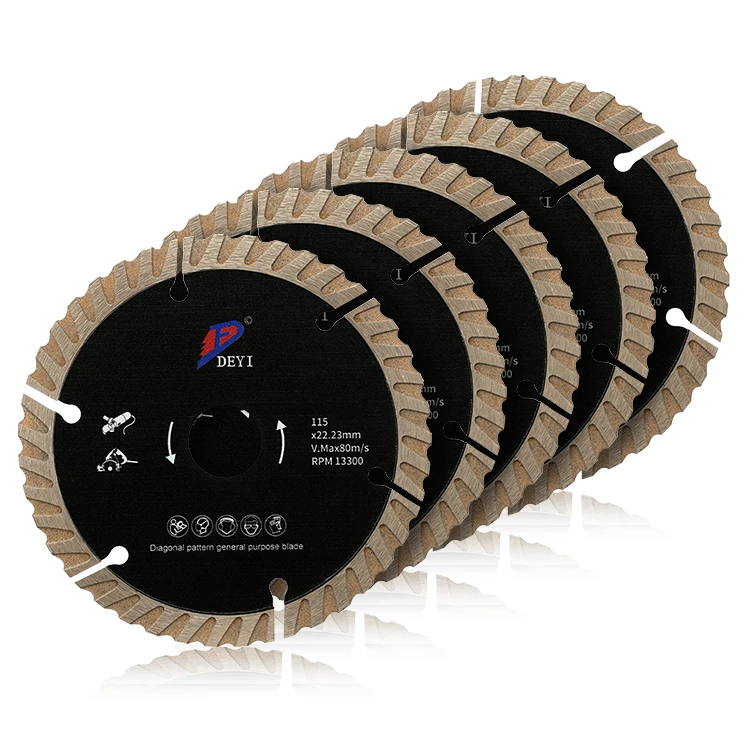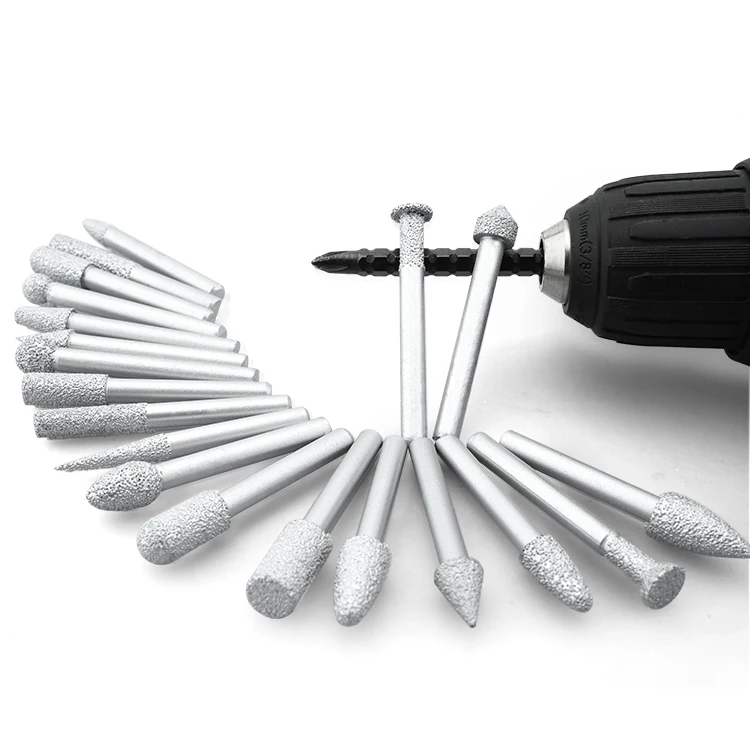የተሻለ የኮንክሪት መታረስ ቁልፍ ምን ያስገኛል?
የ materiał አቀራረብ፡ ካርባይድ እና ዲያማ የኮንክሪት መታረስ ቁልፍ ዘላቂነት እንዴት ያሳድጋሉ
ለዚህ ካርባይድ-ታይፕድ መታረስ ቁልፎች በኮንክሪት ውስጥ የበለጠ የወረር ተቃውሞ የሚሰጡ ምክንያቶች
የተንግስት ካርባይድ በተወሰነ የኮባልት ባለሃብት ጋር በተቀላቀለበት ጊዜ ከ90 እና 92 HRA መካከል ያለውን ጠንካራ የመታመም ደረጃ ያሳያል፣ ይህ የሚገባው ከ8 እስከ 12 ክፍል የሚሆነው ነው። የሚገቡት ነገር የማጠቃለያ ጥንካሬ በመጠበቅ ምክንያት ቢቆርጥ እንኳ ቅიዳ በሚፈስስበት ጊዜ ቅርጽ ለማስቀመጥ ተስፋ የሚሰጥ ነው። ይህ ግንኙነት እስከ 7,000 MPa ድረስ የሚደርስ የግፊት ግጭት ሊቋቋም ይችላል፣ ይህ ማለት የተንግስት ካርባይድ ጫፍ ያለው የማሽን ጫፍ ብዙ ጊዜ የሚቆይ ሲሆን ብዙ ጊዜ የሚጠቀመው በአገገዘ ድንጋይ ላይ ሲሆን የመደበኛ ብረት ጫፎች ከእነዚህ ጋር ሲነፃፀሩ በጣም ትንሽ ነው። በተጨማሪ የተሞላ የቤት ግድግዳ ውስጥ ከ60 በላይ ግንቦታ ለማድረስ የሚያገለግል ካርባይድ ጫፍ ያለው መሳሪያ ሲጠቀም እስከ ማዋል ድረስ ያገለግላል ተብሎ የሚታወቅ ነው። ይህ ዓይነት የማቆሚያ አቅም ከመደበኛ ያልሆኑ የካርባይድ ያልሏቸው አማራጮች ጋር ሲነፃፀር ከሶስት ጊዜ በላይ የሚሆነውን ያሳያል፣ ስለዚህ የመጀመሪያ ዒላማ ከፍተኛ ቢሆንም ረጅሙን ጊዜ የበለጠ የገንዘብ ተመን ይሆናል።
ዲያመንድ ᬩ. ካርባይድ፡ ለማስመቻት የሚያገለግሉ የ durability እና የመተግበሪያ ተስማሚነት ማነፃፀሪያ
የአልማዝ ምታት ያለው ቁስልቶች በከፍተኛ የሙቀት አካባቢ ውስጥ ከካርባይድ ይልቅ በጣም ጥሩ ናቸው፣ 1,200°F ከላይ ያለውን ጥንካሬ ይጠብቃሉ፣ ካርባይድ ግን ከግምት ወደ መቶ የሚሆነው 800°F ላይ ሲደርስ ማበል ይጀምራል። የአልማዝ ዓይነቶች መጀመሪያ ላይ 4–6 ጊዜ የሚቆጠሩ ቢሆኑም፣ በግምት ወደ መቶ የሚሆነው በፈረስ ድንገተኛ ኮንክሪት ውስጥ 300 ከላይ ጥቃን ማድረግ የሚችሉበት ምክንያት ለትላልቅ ፕሮፌሽናል ፕሮጀክቶች የ expense-effective የሆነ ነው።
| ቁሳቁስ | የአክሎ መጠን ክፍፍል | በ 4,000 PSI የኮንክሪት ውስጥ ያሉ ጥቃን | የተሻለ ጥቅም ላይ ዘዴ |
|---|---|---|---|
| ካርባይድ | 1x | 60–80 | የቤት ሰሌዳዎች |
| ዲያማንድ | 4.5x | 300+ | ከፍተኛ የመዋቅር ጥገኝ |
ሙቀትና ግሽበትን መቋቋም የሚያሻሽሉ покሬቶችና የ materiał ማተሚያዎች
የተመቼ የላይ ማተሚያዎች የቢት ዕድሜ በ 30–40% ያረጋግጣሉ። የቲታኒየም አሉሚና ናይትራይድ (TiAlN) pokሬቶች የማሳያ መጠን በ 25% ይቀንሳሉ፣ በሌዘር የተቆለፈ ግስፋይ ግሩቭ በክብ ሁኔታ ውስጥ የሚገባውን ጭካኔ ያቀንሳል፣ እና ዳግም የተሞላ ካርባይድ መዋቅር ውስጥ የሙቀት መበታተን ይጨምራል—በጠንካራ ዲሪሊንግ ሁኔታዎች ስር አፈፃፀም ለማሻሻል አጠቃላይ ያስተዋውቃል።
ከፍተኛ አፈፃፀም ያላቸው ጫፍ የሚያስገቡ የሙቀት መሰብስብ አስተዳደር
አሁኑ የካርባይድ ቢቶች በተደጋጋሚ የሚቀየሩ ፋሉት የማቀፊያ ዲዛይኖች ያለው ሲሆን ባህሪያዊ ሞዴሎች የሚያስተላልፉትን የሙቀት መጠን በ 20% ይበልጣል። ዲያሞንድ የተሸፈነ ክፍሎች የተዋሃዱ የሙቀት ማስቀነስ መንገዶች አሉባቸው፣ የሚሰራውን ሙቀት በ 150–200°F ይቀንሳል። ላይ የሙቀት መከላከያ pokሬቶች ላይ የካርባይድ መሰረቶች አሁን የ 6" ድፍረት ያለውን ሳይ ሙቀት ተጽእኖ ሲፈርስ የማያቋርጥ ዲሪሊንግ ያስችላል፣ ለመሠረተ ልማት መተግበሪያዎች የ 필 ጥገኛ ፍትሐዊ እድገት ነው።
አፈፃፀም የሚያሻሽሉ እና የቢት ዕድሜ የሚያረጋግጡ የመዋቅር ዲዛይን ባህሪያት
የማጣሪያ ቅርጽና ግድግዳ ለተመቻ የንፋስ መውረድና የዕክል ብዛት ስላሳለፍ
የማዞሪያ ጠርዝ ቅርጽ ለንፋሶች መሰባበርና ለሙቀት ማነስ አስፈላጊ ነው። የሚቺጋን ዩኒቨርሲቲ ኢንጂኔሪንግ የ2023 ዓ.ም ጥናት የሄሊካል ጠርዞች ጋር 34°–38° ጣይቶች ከተለመዱ የተሻሉ ቅርጾች ጋር ሲነፃፀር የዕክል ብዛት እስከ 40% ድረስ ይቀንሳል ብሎ ይገልጻል። ይህ የተመቸ ጣይት የአጂግ መሰብሰብ ያስከትላል-Industry ጥናቶች የመጀመሪያ ጊዜ የሚሰራበትን አካል የሚደምስ ነገር በ62% የሚገመተው ነው።
የሽእን ዲዛይን ለሃመር ዳራ ጋር የሚጣጣር ለማረጋገጥና ለተሻለ ክዋኔ
SDS Plus እና SDS Max ምትሃኖች በግምት 0.02 ሚሜ የሚፈቀደው ልዩነት ውስጥ በመቆየት ለረዥሙ ማሽን መሳሪያዎች ጥብቅ ተስማሚነት ያስገኛሉ፣ ይህም ሲጠቀሙ የሚታየውን ጭንቀት ያስቀርጣል። እንደ ASTM International የተሰራ አንዳንድ ጥናቶች ግለጽ ያደረገው፣ መሳሪያዎቹ በትክክል ሲስተምሩ ከፍተኛ ጭንቀት ያላቸውን ኦፕሬሽን ሲከናወኑ የተንጠለጠሉ ቁሳቁስ ያለው ጣፋጭ በተመለስ ከ33% በላይ ረጅም ጊዜ ይቆያል። እነዚህ ምትሃኖች ላይ የተጠበቀው ክፈፍ ላዘር በማታ የተዋሃደ ነው፣ ስለዚህ ከባድ ስራዎችን ለመቋቋም ይችላል። በ 18,000 ቪፒኤም የሚደርስ ተጽእኖን ለረጅም ጊዜ ሳይታመም ወይም ሳይበላሽ ለመቋቋም ተሞክሯል።
በቤተመቻ ውስጥ ስንጠፍ እና መበላሸት ለመቋቋም ጠንካራ ማሰራያ
ሁለ-phase ግንባታ የግራድየንት መዋቅርን ይፈጥራል፡ 62–64 HRC የተሸፈነ ጠርዝ በከበብ ያለውን 54–56 HRC መስቀለኛ ክፍል ይጠላል። በክሊን ላይ የተደረገ ሙከራ የዚህ አቀማመጥ ጥፋት በ 28% ይቀንሳል ስና እያንዳንዱ ልዩ ጣራ ይቆያል። በቢት ግፉ ውስጥ የተቀመጡ የማሞቂያ ገጽታዎች በረጅም ጊዜ የሚጠቀሙበት ጊዜ የሙቀት መጠን በ 140°F ይቀንሳል፣ ይህም የመቆጣጠሪያ ኃይልን ይጨምራል።
SDS ዲሪል ቢቶች ተብሎ የሚታወቁት፡ ለከፍተኛ መቆጣጠሪያ አስፈላጊ የሆነውን ዓይነት ማጣመጥ
SDS፣ SDS Plus፣ እና SDS Max አስተውሎ፡ የተለያዩ ጥቅሞቻቸውና የመቆጣጠሪያ ልዩነቶቻቸው
SDS (Slotted Drive System) ቢቶች የሃመር ዲሪሎች ውስጥ የኃይል ማስተላለፊያ ለማሻሻል የተሰሩ ናቸው። የሶስቱ ዋና ዓይነቶች የተለያዩ ጥቅሞች አሉባቸው፡
| ዓይነት | ከፍተኛ የጠፍጣፋ ንኅስ አልፍ | የተገቢ ጥቅሞች | የመቆጣጠሪያ ምክንያት |
|---|---|---|---|
| SDS-Plus | 1–1/4" | ዝቅተኛ ከ ነጻ ወደ መካከለኛ ኮንክሪት | በደረጃ የሚገነባ የማሲኖሪ ቢቶች ሲነፃፀር 20% የበለጠ የአገልግሎት ዘaman ያለው በደግመኛ ዲሪል ላይ (የ 2023 መሳሪያ አፈጻጸም ዝግጅት) |
| SDS-Max | 2" | ከብረ ብረት ጋር የተዋሃደ ጠንካራ ኮንክሪት | ለጥልቀት ያለው መጫኛ ግስ ማስወገጃ ስራ 35% የበለጠ ግፊት ማስወገጃ አቅም |
ለኮንክሪትና ለከባድ የግንባታ ሥራዎች ተስማሚ የሆነ SDS ቂጣ ምርት
የተደራረቡ ኮንክሪት ግድግዳዎች ለአንከላቾች ግስ ለመፍጠር፣ ከ3/8 ኢንቸር ጀምሮ እስከ አራተኛው ኢንቸር ድረስ ያለው የSDS-ፕሉስ ቂጣ በጣም ጥሩ ይሆናል። ይህ መጠን በትንሹ የመጫን ፍጥነትና በትንሹ የመቆየት ጊዜ መካከል ጥሩ ሚዛን ያቀርባል። ግን ለብረ ብረት የተዋሃዱ መሰረቶች ወይም በግራኒት ጅረት ላይ ከሃያ ሶስት በላይ ግሶች ሲፈጠሩ ሁሉ ነገር ይለያያል። ከዚያ ወዲህ SDS-Max ቂጡ ጠቃሚ ይሆናል፣ በተለይ ደግሞ ከካርባይድ ጫፎች ጋር ያሉት የእነዚህ ቂጡዎች ጠርዞች። በጣም ጠንካራ የሆኑ ንጥረ ነገሮች እነዚህን ቂጡዎች ቀጥታ አይበላሽ ያደርጋቸዋል በዚያ ሁኔታ ከቀላል እኩል ድምቀቶች ጋር ሲነፃፀር። በተፈጸመ ልምምድ የሚያሳይው የሚጫኑ ነገሮች ምን እንደሚጫኑ እና ግሱ ምን ያህል ጥልቅ መሆን አለበት በሚለው ላይ ተመርኮዝቶ ትክክለኛውን SDS ዓይነት ሲመርጡ በግማሽ ያንሳል መለወጥ ያስፈልጋቸዋል ማለት ነው።
ዋና ዋና የመርጠኛ ደንቦች፡ መလክ ፣ ተግባር እና ረጅሙ ጊዜ የሚቆይ ገጽታ
ሶስት ምክንያቶች የ SDS ባት የማይቀር ጊዜን የሚወስኑ ናቸው፡
- የቼክ የሚጣጣመው መሆን ፡ ያልተዛመዱ ሲስተሞች የሚሽከረከር ሁኔታን ያስከትላሉ፣ ይህም የሻንክ ግጠትን ያፋጥናል
- የሙቀት ተቋም ፡ የብረዝ ማዋቂያ በչቦ ላይ ያለ መጠን ከ600°F በላይ የሙቀት መጠን ይቋቋማል
- ግድግዳ ላይ ያለው መዳረሻ ፡ የተዘረጉ ስፒራል ፍሉትስ በቀጥታ ፍሉት አቀማመጦች ጋር ሲነፃፀር የአፍ ማሰባሰቢያን 40% ያቀንሳል
ከፍተኛ የማይቀር ጊዜ በትክክለኛ የቶርክ የማስነሻ ሁኔታዎች እና ተገቢ የገንጠል ሂደቶች ጋር በማጣመር ይገኛል—በመጀመሪያ 10–15 ግልጽ ጥቅሶችን በ50% RPM ማሽከርከር የካርባይድ ግርбан ላይ የተቆጣጠረ ጭነት ለማዘጋጀት። ሁልጊዜ የሻንክ ላይ ያሉ የ ISO 11833 የማረጋገጫ ምልክቶች የሚፈለገውን የጭነት ክልል ያሟላል ወይስ ያለያዩት መሆኑን ያረጋግጡ።
የኮንክሪት ዳራ ባት የመቆራረጥ ጊዜን የሚነኩ የማስነሻ ሁኔታዎች
በጨመቻ እና በչቦ ላይ ያለ መጫኛ፡ በማሰራጨት፣ በአፍ ቁጥጥር እና በባት የማይቀር ጊዜ መካከል ያለው ግንኙነት
የክረም ግስጋሴ ዘዴዎች ከչቦታ ጋር ሲነፃፀር በግጭት የተፈጠረው ሙቀት በግምት 60 ፋራናይት ያስቀድማል። ይህ ካርባይድ ብትስ ምን ያህል ረጅም ይቆያል በመጠን እጅግ ተጽእኖ ያሳድራል። የሚከሰተው ግለሰብ? አዎ፣ ይህ ሂደት ሁልጊዜ አንዳንድ ሳይሮች ይፈጥራል። ነገር ግን፣ ይህ ውሃ ከ400 ፋራናይት በላይ የሚከሰቱ አደገኛ የሙቀት ክፍሳትን በአስፈላጊ ሁኔታ የሚከላከል ሲሆን ይህ በረጅሙ የሚደርስ ክረም ስራዎች ውስጥ በተደጋጋሚ የሚከሰት ነው። ብዙ ሰዎች አሁንም በአቀባዊ ፕሮጀክቶች ላይ በቀላሉ ማስተካከል የሚቻል ስለሆነ የጨረታ ዘዴዎችን ይመርጣሉ። ሆኖም ግን፣ ከተለያዩ የማርሲነሪ መሳሪያ ማምረቻ ኩባንያዎች የሚመጡ ጥናቶች ሙሉ በሙሉ ለጨረታ ዘዴ ሲተዉ ብትስ ረጅም የሚቆይበትን ጊዜ ከአንድ ሦስተኛ ያጠፋል እንደሚያመለክት ያሳያሉ።
ሙቀት መጨመር ኩርባይት ጫፍ ያለው የኮንክሪት መታረሻ ብትስ አፈጻጸም እንዴት ይቀንሳል
ከፍተኛ ሙቀት በካርባይድ ውስጥ ያለውን ኮባልት የሚያገናኝ ማትሪክስ ያ mềmታል፣ ይህም የማቆራረጥ ግጭቶች ፍጭ መበላሸትን ያስከትላል። በ750°F ከሚደርስ በላይ የሙቀት መጠን—የተፈጥሯዊ ኮንክሪት ውስጥ ያለ ሲሆን ተስማሚ ማሰናጃ ከሌለ—የብቃት መቋቋም ኃይል በ40% ይቀንሳል። ይህ የሙቀት ምክንያት የሚፈጠር ጉድለት የማቆራረጥ ግጭቶችን ያዞረዋል፣ የሚፈለገውን የወደ ታች ግፊት በ3–4 ጊዜ ይጨምራል እና የፍሉቱ ግጭት ፍጭ መበላሸትን ያፋጥናል።
መጀመሪያ የሚሰራውን ግጭት እንዲቀንስ የማስቀመጫ ፍጥነት እና ግፊት በአሁኑ ጊዜ ለመቀነስ
| ካልኩላቶች | የሚመከር ነጥብ | መግቢያ |
|---|---|---|
| የሽግግር ፍጥነት | ለ1/2" ቢቶች 500–800 RPM | የአፍታዎቹ ግርማ ማፈስ ይከላከላል |
| የወደ ታች ግፊት | ለእጅ ማስቀመጫ መኪኖች 15–25 ፊ ፒ ኤስ | የማቆራረጥ ሂደት ያለ መቆለፍ ይጠብቃል |
መሳሪያ የኃይል ፈተና ውሂብ መሰረት፣ ምርቃት ማስቀመጫ ሞード “rotation only” ሁነታ በመጠቀም ለመጀመሪያ ግጭት ላይ ያለው ጭንቀት በ18% ይቀንሳል።
የመገልገያ ቦታዎች ላይ ያሉ የአካባቢ ሁኔታዎች የቢት መበላሸትን የሚፈጥሩ
በչቀጠቀተ መቆረጥ ጊዜ የሚፈጠር የማፍተሻ ጭስ እንደ አሳ ማለት ያለው ግድግዳ አካል ይሆናል፣ በእጅግ የሚያፍነውም የማሽን ቅርጽፍ ላይ ያሉ ፍሎት ቻናሎች ናቸው። ሁኔታዎቹ ከባድ ወይም ከ40 ዲግሪ ፋራን ሄት በታች ሙቀት ሲሆን በትክክል ካልተጠበቀ የብረት ግፉ ቀላል ማፍሰስ ይጀምራል። የባህር ረብስ ወይም ከባህር ጋር ባጠገዝ የሚሰሩ ሰንሰርቶች ንገረ ነገር አስተዋልቀዋል። ባሕር ውሃ ከኮንክሪት ጋር ተቀላቅሏል ማለት ሌላ የችግር ስብስብ ማመጣጠን ነው። የሚያደርጉት መንገድ በሞሌኩል ውስጥ ያሉ ኬሚካሎች ከተቀላቀሉ የአካላት ጋር እንዲዛመዱ ስለሚያደርጉ ካርባይድ መበላሸት በዚያ ቦታ በግምት 22 በመቶ ፈጣን ይከሰታል። ይህ ዓይነቱ ነገር በዚህ ዓይነት የሥራ ቦታዎች ላይ የציוד ረጅም ዕድሜ ለማድረግ በጣም ጠቃሚ ነው።
የኮንክሪት መቆረጥ ቢት ዕድሜ ለማራዘም የሚከተሉ የጥገኛነት ምርጥ ዘዴዎች
የማፍተሻ ክስተት ለማስቀረት እና ለማፍሰስ ለማስቀረት በየጊዜው የማስወገድ ሂደት
በኮንክሪት ውሃ እና በአጠቃቀም ላይ ያሉ ክፍሎች በፍሉጦች ውስጥ በፍጥነት ይሰባብታሉ፣ የማሳያ መጠን እና ሙቀት ይጨምራል። በጠንካራ ኒሎን ቦሮቶች እና በተጎለበተ አየር ሲታፈስ በእያንዳንዱ 3-5 ጠርዝ ውስጥ ባለው ሙከራ ላይ የሙቀት ምክንያት የሚከሰተው ግድግዳ በ62% ይቀንሳል። ለመቆረጥ የሚቻል የማይፈስስ ምርጥ ለሆነው ምርት ግን የ-pH ነጻ የማጽጃ አገልግሎት በ10 ደቂቃ ውስጥ የሚያስወጣው ሲሆን የካርባይድ መዋቅር አይበላሽም።
የመጀመሪያ ጥቃት ለማቃጠል ትንሽ ቁሳቁስ በመጠቀም የመጫን ጭንቀት ለማ RID እና የመሳሪያ ዕድሜ ለማራዘም
በ¼" ቢት መጀመር ከዚያም ወደ ሙሉ ዲያሜትር ማለት የሚለው የሜካኒካል ጭነት በሁሉም ደረጃዎች ይሰራጫል። ይህ ዘዴ የከፍተኛው የሞመንት ፍላጎት በ33–40% ይቀንሳል፣ ከዓለም አቀፍ የማስቀመጫ ባለሙያዎች ግንኝት (IADC 2023) የሚመራው ስሞኑ መሰረት። ከመስክ የሚመጡ ዝገቦች የመጀመሪያው ቢት ዕድሜ በ28% ይጨምራል ተብሎ ያሳያሉ ይህን የደረጃ ዘዴ በመጠቀም ጊዜ
የዋናው መዋቅር ጥንካሬ ለመጠበቅ ትክክለኛ መጠበቂያ እና መተግበሪያ
የሲሊካ ጂል ጥቅልሎች ያሉት የተከፈሉ ሳጥኖች ውስጥ ቁሶችን ያከማቹ እና የእርጥበት መጠን ከ 35% በታች ሆኖ ይቆይ እና ባለ ካርባይድ ግጭቶች ምክንያት የሚፈጠሩ የማይታወቁ ግጭቶች ይቀንሳሉ። የመስክ ጥናቶች የአየር ንብረት ቁጥጥር ያለው የማከማቻ ስርዓት ከክፍት መሣሪያ ሳጥኖች ጋር ሲነፃፀር የገጽ ጠርዝቶችን 30% ያቀንሳል። ሲተላለፍ፣ የመሰረቱ ክፍሎች በፎም ውስጥ ይጠብቁ እና የመጨረሻ ግጭቶች የሚከሰቱበትን የማጣራት ግንባታ ይከላከሉ።
ተደጋጋሚ ጥያቄዎች
የካርባይድ ጫፍ ያለው የማሽከርከር ቁሳቁስ ለመደበኛ ብረት ቁሳቁስ የሚበልጥ የመቆራረጥ ችሎታ ያለው ለምን ነው?
የካርባይድ ጫፍ ያለው የማሽከርከር ቁሳቁስ የቱንግስቴን ካርባይድ አካል ምክንያት የበለጠ አገጃግዢ ያለው ነው፣ ይህም ከመደበኛ ብረት ቁሳቁስ ጋር ሲነፃፀር የበለጠ ግፊት የመቋቋም ችሎታ አለው እና በከባድ ሁኔታዎች ስር የበለጠ ይቆያል።
የአልማዝ ግርማ ያለው ቁሳቁስ ከካርባይድ ጋር ሲነፃፀር ለኮንክሪት ማሽከርከር ስለ ምን ይለያያል?
የአልማዝ ግርማ ያለው ቁሳቁስ ዋጋ ይበልጣል ግን በከፍተኛ የሙቀት አካባቢዎች ውስጥ ከካርባይድ በላይ አፈፃፀም ያሳያል እና የ Integrity ን የበለጠ ይጠብቃል፣ ይህም ትላልቅ ፕሮፌሽናል ፕሮጀክቶች ለሚሰሩ ዋጋ-አፈጻጸም ያለው ነው።
በቦርቦሮች ላይ የተራቀቁ ሽፋኖችን መጠቀም ምን ጥቅም አለው?
ቲታኒየም አሉሚና ናይትራይድ (TiAlN) የሚባለው የተመቸ покሬሽን ማበልጥ ያቀንጣል፣ ሙቀት ማሰባሰብ ይከላከላል እና ዳርቶቹ በጠንካራ ሁኔታ ላይ በተመሳሳይ የሚሰሩበትን ጊዜ ይጨረስ ያደርገዋል፣ ይህም በከፋ ሁኔታዎች ስር በተሻለ ልክ እንዲሰሩ ያደርጋቸዋል።
የዳርት መታጠቢያ ዕቃ ዕድሜ ላይ ውሃ ያለው መታጠቢያ እንዴት ይነግረዋል?
እርጥብ በሆነ መንገድ መቦርቦር ሙቀትን በእጅጉ ይቀንሳል፤ ይህም የመቦርቦር ጡጦዎች ዕድሜ እንዲረዝም ያደርጋል። ይሁን እንጂ ይህ ዘዴ ጭቃ የሚፈጥር ከመሆኑም ሌላ በተወሰኑ የስራ ቦታዎች ላይ እንደ ደረቅ ቁፋሮ ተግባራዊ ሊሆን አይችልም።
የኮንክሪት ዳርት መታጠቢያ ዕቃ ዕድሜ ሊያረጋግጥ የሚችሉ ምን ዓይነት ዘዴዎች አሉ?
የተደጋጋሚ ፍጹም ማጽጃ፣ ትንሽ ዳርቶች ጋር የመጀመሪያ መታጠቢያ እና ትክክለኛ መጠበቂያ የኮንክሪት ዳርት መታጠቢያ ዕቃ ዕድሜ በከፍተኛ ሁኔታ ሊያረጋግጥ ይችላል፣ ስለዚህ ጭንቀት ይቀንሳል፣ ሙቀት ማሰባሰብ እና ፊዚካዊ ጉድለት ይከላከላል።


